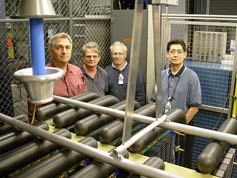
Handy Links
SLAC News Center
SLAC Today
- Subscribe
- Archives: Feb 2006-May 20, 2011
- Archives: May 23, 2011 and later
- Submit Feedback or Story Ideas
- About SLAC Today
SLAC News
Lab News
- Interactions
- Lightsources.org
- ILC NewsLine
- Int'l Science Grid This Week
- Fermilab Today
- Berkeley Lab News
- @brookhaven TODAY
- DOE Pulse
- CERN Courier
- DESY inForm
- US / LHC
SLAC Links
- Emergency
- Safety
- Policy Repository
- Site Entry Form

- Site Maps
- M & O Review
- Computing Status & Calendar
- SLAC Colloquium
- SLACspeak
- SLACspace
- SLAC Logo
- Café Menu
- Flea Market
- Web E-mail
- Marguerite Shuttle
- Discount Commuter Passes
-
Award Reporting Form
- SPIRES
- SciDoc
- Activity Groups
- Library
Stanford
Around the Bay
New Modulator Technology Looks Feasible for ILC
 A new type of modulator developed at SLAC reached important milestones on Wednesday, making it feasible to more reliably and less expensively provide power to accelerate particles at the proposed International Linear Collider (ILC).
A new type of modulator developed at SLAC reached important milestones on Wednesday, making it feasible to more reliably and less expensively provide power to accelerate particles at the proposed International Linear Collider (ILC).
"This is a great accomplishment with very positive consequences for the ILC. Thanks to all involved for their hard work," said Gerry Dugan, regional director for ILC Americas.
The ILC Marx Modulator, developed by Greg Leyh with Piotr Blum in the Power Conversion Engineering group, successfully delivered 120,000 volts at a current of 140 amperes, the voltage and current required by the klystrons, which pump power into the linear accelerator to accelerate electrons and positrons. Modulators convert AC power into specifically shaped pulses of DC power that can be used by klystrons.
The ILC baseline design currently includes fully proven modulators that are considerably larger, more expensive, and less efficient than the Marx Modulator. If the new modulator demonstrates reliable full power operation by successfully completing a planned 2,000 hour test, it will be proposed as the new Baseline.
"Congratulations to Greg for his innovation and leadership, and to the entire team for their inventive, elegant hard work," said Project Manager Ray Larsen. "The Marx indeed looks promising to deliver a new era of intelligent, efficient power modulator electronics."
On February 21, the modulator generated a 120,000 volt pulse with a narrow pulse width. Later in the day, the team produced a pulse with the full 1,400 microsecond width needed by the ILC, at 100,000 volts. The next step is to operate at high power, producing full width pulses at the full voltage and at high repetition rate.
"The modulator consists of cells, which contain capacitors that can store 12,000 volts," Leyh explained. "The capacitors get charged in parallel from a 12,000 volt power supply. Once they're charged, the trick is to activate the solid state switches on the cells to connect the capacitors in series, so the voltages add to 120,000 volts."
The pulses need to be perfectly rectangular, with a flat top at 120,000 volts, and a width of 1,400 microseconds. Another next step is to add further regulation and control circuits to ensure an even discharge of voltage, so the pulse top stays flat. The voltage drops in the capacitors as they deliver current, so the control system can call on extra capacitors to compensate for the "droop" in voltage. The ILC design calls for a total of 630 klystrons, with one modulator to pair with each klystron.
Overall, the modulator is designed for high availability. Components like solid state switches, capacitors and cells have a level of redundancy so the modulator does not shut down if a single unit fails. If the modulator is as reliable as expected, it should never interrupt ILC operation.
—Heather Rock Woods, February 23, 2007
Above image: Greg Leyh, Jeff Olsen, Piotr Blum and Alfred Viceral stand next to the Marx modulator. (Click on image for larger version.)